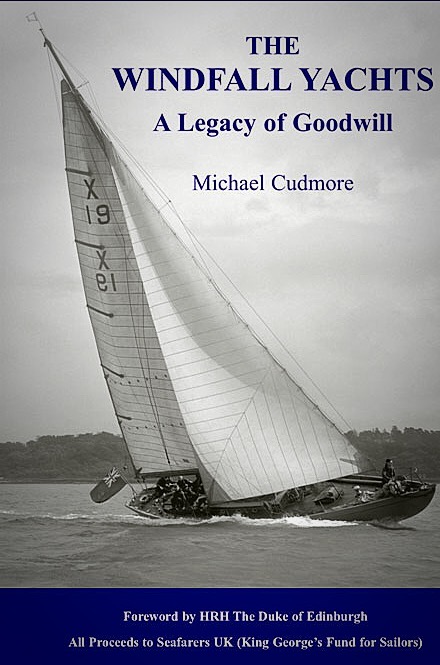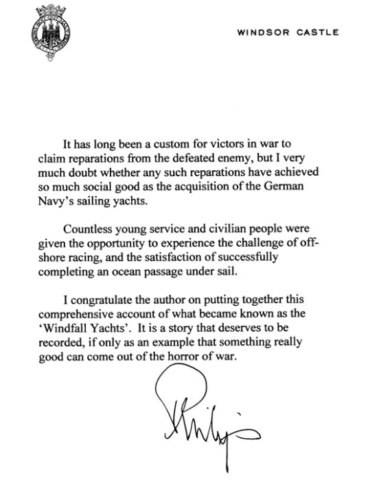
Sail Number: III/29
Type: Seefahrtkreuzer 30 qm (Windfall fleet)
LOA: 32’0” / 9.75m – LOD: 32’0” / 9.75m – LWL: 21’4” / 6.50m – Beam: 7’3” / 2.20m – Draft: 4’6” / 1.36m – Designer: Abeking & Rathmussen, Lines according to construction no. 2926 – Original Owner: Arsenal Kiel-Wiek (MRV) (name Odin) – Current Owner: James Green – Year Launched: 1936 – Built by: Abeking & Rathmussen, No. 3006 – Hull material: Wood (Mahogany on Oak) – Sail Area: 30-m² – Sv=Si(1.164-(0.21G/Si)) – Displacement: 6,000 lbs – Ballast: Lead – Engine: none
Historical:
Winwood, originally named Odin, was launched in 1936 as a Seefahrtkreuzer for use by the Luftwaffe and Kriegsmarine during World War II, primarily as regatta and recreational vehicles. Also said to have been used on a larger scale for secret reconnaissance, courier and espionage trips in foreign waters.
After the end of World War II, in 1945, approximately 100 of these vessels were taken as reparations from Germany by British forces, liberated, and used as winfall for sail-training and honing British’s navigation skills. For fifteen to twenty years they served the British valiantly, until their decommissioning, and release to private ownership.
The Windfall Yachts – A Legacy of Goodwill by Michael Cudmore
Foreword by H.R.H The Duke of Edinburgh (see photo)

Michael Cudmore – The yachts were built in Germany in the 1930s to provide training for the German armed services. They were owned by the German Government and after the war were taken by the British Government as reparations. The majority were then sailed to England, where they were promptly dubbed Windfalls and initially allocated to Navy, Army and Air Force of the British and Commonwealth Services.
The yachts varied in size from 85 ft to 32 ft and included some very fine large craft. During the 1940’s the Windfall fleet was mainly condensed to three main classes: 100 square metre (sq m), 50 sq m and 30 sq m, with an overall length of 55 ft, 42 ft and 32 ft respectively. Virtually all are now under private ownership, sailing as classic boats and much admired at classic boat rallies or Tall Ships Races.
Despite being built for use in the Baltic they have since sailed far and wide, cruising extensively and racing in most of the Northern Hemisphere offshore races including the Fastnet, Bermuda and Trans-Atlantic Races. That they were very well constructed is amply demonstrated by the fact in 70 years not one has been lost at sea due to stress of weather.
The Seefahrtkreuzer Class
During the “Seglertag”-meeting in the state hall of the Vienna Hofburg in October 1927, aside from the big entertainment program, the question of which basis a new class for coastal and offshore racing should have, was discussed very controversially. The only yachts attempting to fulfil this purpose were the “Nationale Kreuzer”-class, but they had proven unfit.
Opposing parties were most of the German sailing clubs under the lead of the NRV and a team of 7 experts deployed by the “Deutscher Seglerverband”. The sailing clubs pleaded for a new so called ‘KR’-formula, similar to the International Rule which put the most important measures of the hull, the rig and the sail area in a mathematical relationship. Resulting from the calculations was a ‘KR’-value instead of ‘mR’-value. The 7 naval architects of the expert committee argued for classes with corresponding limit measures for length, depth, displacement, sail area, etc. Interestingly it was the committee arguing that a mathematical formula would first and foremost serve them as naval architects and not the owners, because these wouldn’t know what they’d get. The committee argued that architects always look for loopholes in the rule, in order to design the fastest yacht possible, the problem being that this leads to extreme designs which only favour speed. In an article written for the “Freundeskreis Klassische Yachten”, Klaus Kramer quotes the chairman of the commission Harry Wustrau: “Every measurement formula practically puts the buyer in the hands of the naval architect. It is wrong to say that the buyer gains the freedom of building whatever he wants. On the contrary, he will have to build what the naval architect wants, because every naval architect must have the ambition to exploit the formula in such a way, that produces the fastest yacht.”
It is a different story with the establishing of limit measures, because they decide the room, speed, seaworthiness and comfort relatively independent of the designer. “If we”, continues Wustrau, “muster the courage – finally, now – to set per-class limits to width, displacement and spaciousness as great as possible, based on proven designs and at the same time limit length, draft and rig-height as possible, then the results will certainly be solid and useable cruisers. The naval architect then has the thankworthy task to draw the fastest yacht around these requirements and limitations.”
The spokesman of the KR supporters, Erich Laeisz, agreed in the end under the condition that the sailing clubs asking for considering the compensation of different rigging types of two masted yachts, as well as the establishment of sail height being taken into account.
This compromise did not only save the following ball-night, but it lead to the construction regulations for the “Seefahrtkreuzer”-class-structure, devided into 30, 40, 50, 60, 80, 100, 150 and 250 sqm. This started the success story of the “Seefahrtkreuzer”-class.
Provenance
- Owner/Guardian: Arsenal Kiel-Wiek (MRV)
- Owner/Guardian: Lee Nyboer, Grosse Point, USA
- Owner/Guardian: James Green
Resources
James Green
Seefahrtkreuzer Register (Register of all seafaring cruisers known (to us), based on the ASMY and FKY register (RKY) and a list of Thorsten Wildies (Wedel), continued by Jan Huerkamp, 2004)
Register – takel-ing.de
WindFall Yachts
Yacht AR





